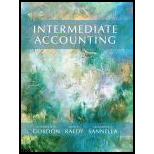
Intermediate Accounting
1st Edition
ISBN: 9780132162302
Author: Elizabeth A. Gordon, Jana S. Raedy, Alexander J. Sannella
Publisher: PEARSON
expand_more
expand_more
format_list_bulleted
Textbook Question
Chapter 16, Problem 16.15E
Notes Receivable. Each of the following three columns refers to an independent case. All data represent amounts as of January 1, the date on which the long-term notes receivable were issued except for the interest income, which is for the life of the note. Assume annual interest payments. Fill in the missing information identified by the letters A through I.
| Item | Case 1 | Case 2 | Case 3 |
| Notes receivable, face value | $900,000 | $1,000,000 | $2,000,000 |
| Initial carrying value | A | $901,819 | G |
| Market rate | B | 8% | H |
| Stated rate | 8% | 7% | 10% |
| Term of notes 1 in years) | 20 years | D | 5years |
| Note receivable discount | (153,244) | E | 1 |
| Interest income over the note's term | C | F | 1,200,000 |
Expert Solution & Answer
Want to see the full answer?
Check out a sample textbook solution
Students have asked these similar questions
Please provide the correct solution to this financial accounting question using valid principles.
I need help with this financial accounting problem using accurate calculation methods.
Please give me true answer this financial accounting question
Chapter 16 Solutions
Intermediate Accounting
Ch. 16 - Prob. 16.1QCh. 16 - Is reporting an investment at its cost considered...Ch. 16 - Prob. 16.3QCh. 16 - Prob. 16.4QCh. 16 - Prob. 16.5QCh. 16 - Prob. 16.6QCh. 16 - What categories can managers use to classify...Ch. 16 - When is the equity method of accounting for...Ch. 16 - Prob. 16.9QCh. 16 - Can companies apply the fair value option to all...
Ch. 16 - What is the fair value hierarchy for investment...Ch. 16 - Prob. 16.12QCh. 16 - Prob. 16.13QCh. 16 - Prob. 16.14QCh. 16 - Prob. 16.15QCh. 16 - Prob. 16.16QCh. 16 - Prob. 16.17QCh. 16 - Deutsch Imports has three securities in its...Ch. 16 - Prob. 16.2MCCh. 16 - Prob. 16.3MCCh. 16 - Prob. 16.4MCCh. 16 - Prob. 16.5MCCh. 16 - Prob. 16.6MCCh. 16 - Prob. 16.7MCCh. 16 - Prob. 16.1BECh. 16 - Prob. 16.2BECh. 16 - Debt Investments, Trading. Using the information...Ch. 16 - Prob. 16.4BECh. 16 - Prob. 16.5BECh. 16 - Prob. 16.6BECh. 16 - Prob. 16.7BECh. 16 - Prob. 16.8BECh. 16 - Notes Receivable. Aaron Anatole accepted a...Ch. 16 - Prob. 16.10BECh. 16 - Prob. 16.11BECh. 16 - Prob. 16.12BECh. 16 - Debt Investments. Impairments. IFRS. For each debt...Ch. 16 - Prob. 16.14BECh. 16 - Prob. 16.15BECh. 16 - Prob. 16.1ECh. 16 - Prob. 16.2ECh. 16 - Prob. 16.3ECh. 16 - Prob. 16.4ECh. 16 - Prob. 16.5ECh. 16 - Prob. 16.6ECh. 16 - Debt and Equity Investments, Available-for-Sale...Ch. 16 - Prob. 16.8ECh. 16 - Prob. 16.9ECh. 16 - Prob. 16.11ECh. 16 - Equity-Investments, Equity Method. Book Value of...Ch. 16 - Prob. 16.13ECh. 16 - Prob. 16.14ECh. 16 - Notes Receivable. Each of the following three...Ch. 16 - Prob. 16.16ECh. 16 - Prob. 16.17ECh. 16 - Prob. 16.18ECh. 16 - Prob. 16.19ECh. 16 - Prob. 16.20ECh. 16 - Prob. 16.21ECh. 16 - Prob. 16.22ECh. 16 - Prob. 16.23ECh. 16 - Prob. 16.1PCh. 16 - Debt Investments, Trading. Freder Software Group...Ch. 16 - Prob. 16.3PCh. 16 - Equity Investments, Readily Determinable Fair...Ch. 16 - Prob. 16.5PCh. 16 - Prob. 16.6PCh. 16 - Prob. 16.7PCh. 16 - Prob. 16.8PCh. 16 - Prob. 16.9PCh. 16 - Equity Investments, Equity Method, Fair Value...Ch. 16 - Prob. 16.11PCh. 16 - Prob. 16.12PCh. 16 - Prob. 16.13PCh. 16 - Prob. 16.14PCh. 16 - Prob. 16.15PCh. 16 - Prob. 16.16PCh. 16 - Prob. 16.17PCh. 16 - Prob. 1JCCh. 16 - Prob. 2JCCh. 16 - Prob. 1FSACCh. 16 - Prob. 1SSCCh. 16 - Prob. 1BCCCh. 16 - Prob. 2BCC
Knowledge Booster
Learn more about
Need a deep-dive on the concept behind this application? Look no further. Learn more about this topic, accounting and related others by exploring similar questions and additional content below.Similar questions
- Please provide the correct answer to this general accounting problem using accurate calculations.arrow_forwardI need help finding the correct solution to this financial accounting problem with valid methods.arrow_forwardCan you solve this financial accounting question with the appropriate financial analysis techniques?arrow_forward
arrow_back_ios
SEE MORE QUESTIONS
arrow_forward_ios
Recommended textbooks for you
- Principles of Accounting Volume 1AccountingISBN:9781947172685Author:OpenStaxPublisher:OpenStax College
 College Accounting, Chapters 1-27AccountingISBN:9781337794756Author:HEINTZ, James A.Publisher:Cengage Learning,
College Accounting, Chapters 1-27AccountingISBN:9781337794756Author:HEINTZ, James A.Publisher:Cengage Learning, Intermediate Accounting: Reporting And AnalysisAccountingISBN:9781337788281Author:James M. Wahlen, Jefferson P. Jones, Donald PagachPublisher:Cengage Learning
Intermediate Accounting: Reporting And AnalysisAccountingISBN:9781337788281Author:James M. Wahlen, Jefferson P. Jones, Donald PagachPublisher:Cengage Learning  College Accounting (Book Only): A Career ApproachAccountingISBN:9781337280570Author:Scott, Cathy J.Publisher:South-Western College Pub
College Accounting (Book Only): A Career ApproachAccountingISBN:9781337280570Author:Scott, Cathy J.Publisher:South-Western College Pub

Principles of Accounting Volume 1
Accounting
ISBN:9781947172685
Author:OpenStax
Publisher:OpenStax College

College Accounting, Chapters 1-27
Accounting
ISBN:9781337794756
Author:HEINTZ, James A.
Publisher:Cengage Learning,

Intermediate Accounting: Reporting And Analysis
Accounting
ISBN:9781337788281
Author:James M. Wahlen, Jefferson P. Jones, Donald Pagach
Publisher:Cengage Learning

College Accounting (Book Only): A Career Approach
Accounting
ISBN:9781337280570
Author:Scott, Cathy J.
Publisher:South-Western College Pub
7.2 Ch 7: Notes Payable and Interest, Revenue recognition explained; Author: Accounting Prof - making it easy, The finance storyteller;https://www.youtube.com/watch?v=wMC3wCdPnRg;License: Standard YouTube License, CC-BY